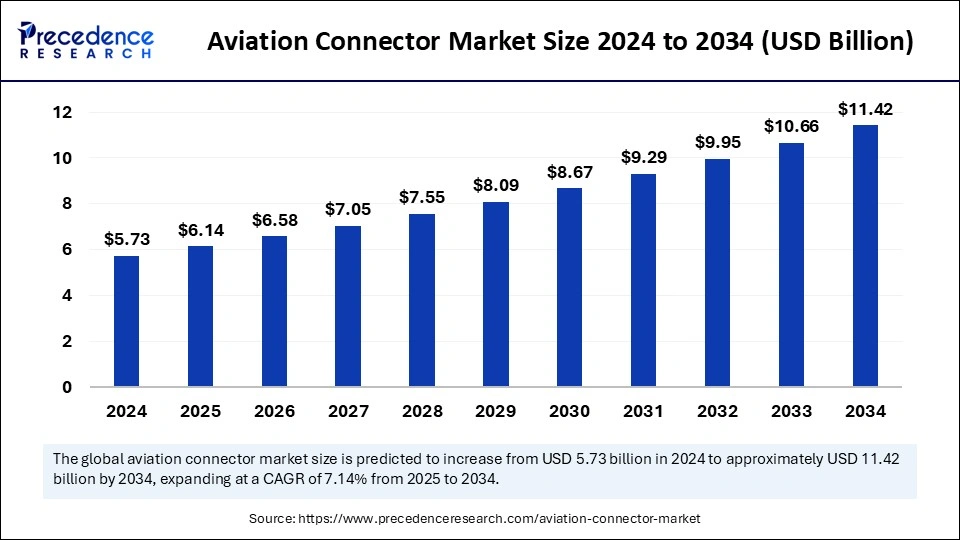Aviation Connector Market Size to Surpass USD 11.42 Bn by 2034
Aviation Connector Market Size and Forecast 2025 to 2034
The global aviation connector market size was valued at USD 5.73 billion in 2024 and is expected to surpass around USD 11.42 billion by 2034, growing at a CAGR of 7.14% from 2025 to 2034.

Aviation Connector Market Key Points
-
In 2024, North America led the market, accounting for a 36% share.
-
Asia Pacific is anticipated to experience the highest growth rate with a 10% CAGR in the near future.
-
The fiber optic connectors segment dominated the type segment, holding a 31% market share in 2024.
-
The high-power connectors segment is projected to register the fastest growth during the forecast period.
-
The commercial aircraft segment emerged as the largest contributor to the market in 2024 by aircraft type.
-
The business and general aviation aircraft segment is expected to witness significant expansion in the forecast period.
-
The engines segment retained the dominant market share by application in 2024.
-
The in-flight entertainment (IFE) systems segment is forecasted to grow at the highest CAGR in the coming years.
Get a Free Sample Copy of the Report@ https://www.precedenceresearch.com/sample/5769
Role of AI in the Aviation Connector Market
Artificial Intelligence (AI) is revolutionizing the aviation connector market by enhancing efficiency, reliability, and predictive maintenance capabilities. AI-driven analytics optimize the design and manufacturing of aviation connectors by analyzing vast datasets to improve material selection, signal transmission efficiency, and durability.
AI-powered simulation tools assist in predicting stress points, wear and tear, and potential failures, ensuring the development of high-performance connectors suitable for modern aircraft systems. Additionally, AI helps streamline production processes by automating quality control inspections, reducing errors, and enhancing overall manufacturing precision.
In the operational phase, AI is instrumental in predictive maintenance, where machine learning algorithms analyze real-time data from aircraft systems to detect anomalies in connectors before failures occur. This reduces downtime, prevents costly repairs, and enhances flight safety. AI-driven connectivity solutions are also improving communication networks within aircraft, ensuring seamless data transmission between avionics systems, in-flight entertainment, and navigation equipment.
As aviation technology continues to evolve with trends such as smart aircraft and more electric aircraft (MEA), AI will play a crucial role in optimizing aviation connectors for enhanced performance, reliability, and safety.
Aviation Connector: Overview and Key Insights
Overview
Aviation connectors are specialized electrical connectors designed for use in aircraft systems, ensuring reliable signal and power transmission in harsh environments. These connectors are built to withstand extreme temperatures, vibrations, and electromagnetic interference while maintaining high performance in aerospace applications. They are essential components in avionics, flight control systems, in-flight entertainment, and communication networks.
Key Features of Aviation Connectors
-
High Durability – Resistant to extreme temperatures, pressure changes, and mechanical stress.
-
Lightweight & Compact – Designed to reduce aircraft weight while ensuring high efficiency.
-
EMI & RF Shielding – Protects against electromagnetic interference for uninterrupted performance.
-
Sealed & Corrosion-Resistant – Offers protection against moisture, chemicals, and environmental factors.
-
High-Speed Data Transmission – Supports modern aircraft systems with fast and reliable connectivity.
Types of Aviation Connectors
-
Fiber Optic Connectors – Used in high-speed data transmission for avionics and communication.
-
High-Power Connectors – Designed for electrical power distribution in aircraft systems.
-
RF Connectors – Used for wireless communication and radar systems.
-
Circular Connectors – Commonly used in avionics and flight control applications.
-
Rectangular Connectors – Provide high-density connections for complex aircraft systems.
Applications of Aviation Connectors
-
Avionics Systems – Used in navigation, flight control, and cockpit instrumentation.
-
Engines & Power Distribution – Ensure seamless power transmission to aircraft components.
-
In-Flight Entertainment & Connectivity – Supports passenger screens, Wi-Fi, and communication systems.
-
Radar & Communication Systems – Essential for air traffic control and military applications.
-
Cabin Lighting & Safety Systems – Integrated into aircraft lighting, emergency systems, and sensors.
Market Scope
| Report Coverage | Details |
| Market Size by 2034 | USD 11.42 Billion |
| Market Size in 2025 | USD 6.14 Billion |
| Market Size in 2024 | USD 5.73 Billion |
| Market Growth Rate from 2025 to 2034 | CAGR of 7.14% |
| Dominated Region | North America |
| Fastest Growing Market | Asia Pacific |
| Base Year | 2024 |
| Forecast Period | 2025 to 2034 |
| Segments Covered | Type, Application , Aircraft, and Regions |
| Regions Covered | North America, Europe, Asia-Pacific, Latin America and Middle East & Africa |
Market Dynamics
Drivers
The rapid modernization of commercial and military aircraft is a key driver of the aviation connector market. As airlines and defense forces upgrade their fleets, the demand for high-speed data transmission, secure communication, and efficient power distribution connectors is increasing. The growing implementation of advanced safety systems, avionics, and real-time monitoring technologies in aircraft is also fueling the adoption of high-performance connectors.
Opportunities
A major opportunity for the aviation connector market lies in the increasing demand for 5G-enabled aircraft communication systems. As airlines and private aviation firms invest in enhanced connectivity solutions, there is a rising need for advanced connectors that support high-frequency data transmission. Additionally, the expansion of aerospace R&D programs focused on autonomous and AI-driven aircraft presents new opportunities for the development of intelligent, self-diagnosing connectors.
Challenges
The biggest challenge for the aviation connector industry is ensuring long-term reliability and performance in extreme environmental conditions. Aircraft connectors must withstand high temperatures, pressure variations, and mechanical stress, requiring advanced materials and precision engineering. Additionally, economic fluctuations and geopolitical uncertainties can impact aircraft production rates and, consequently, the demand for aviation connectors.

